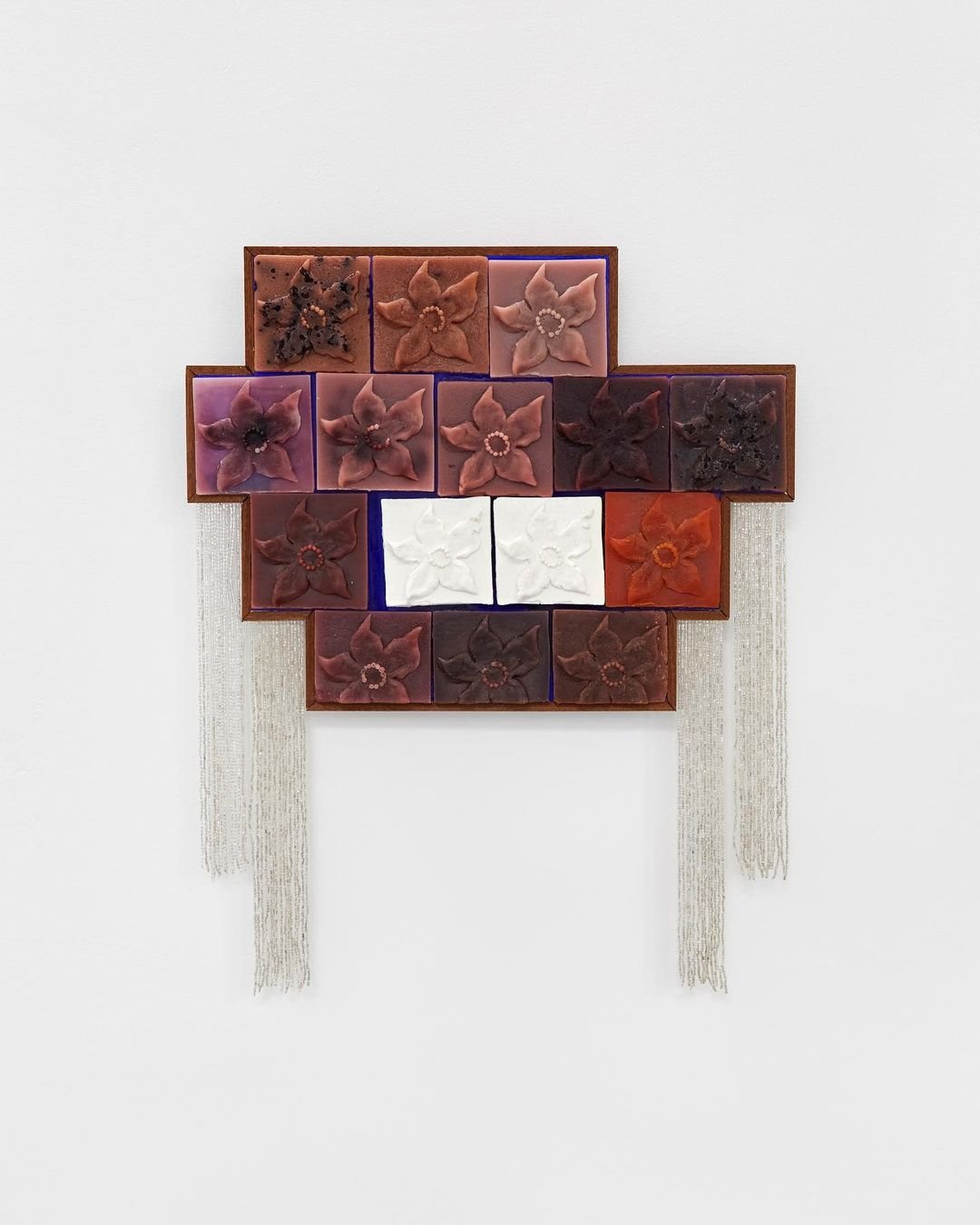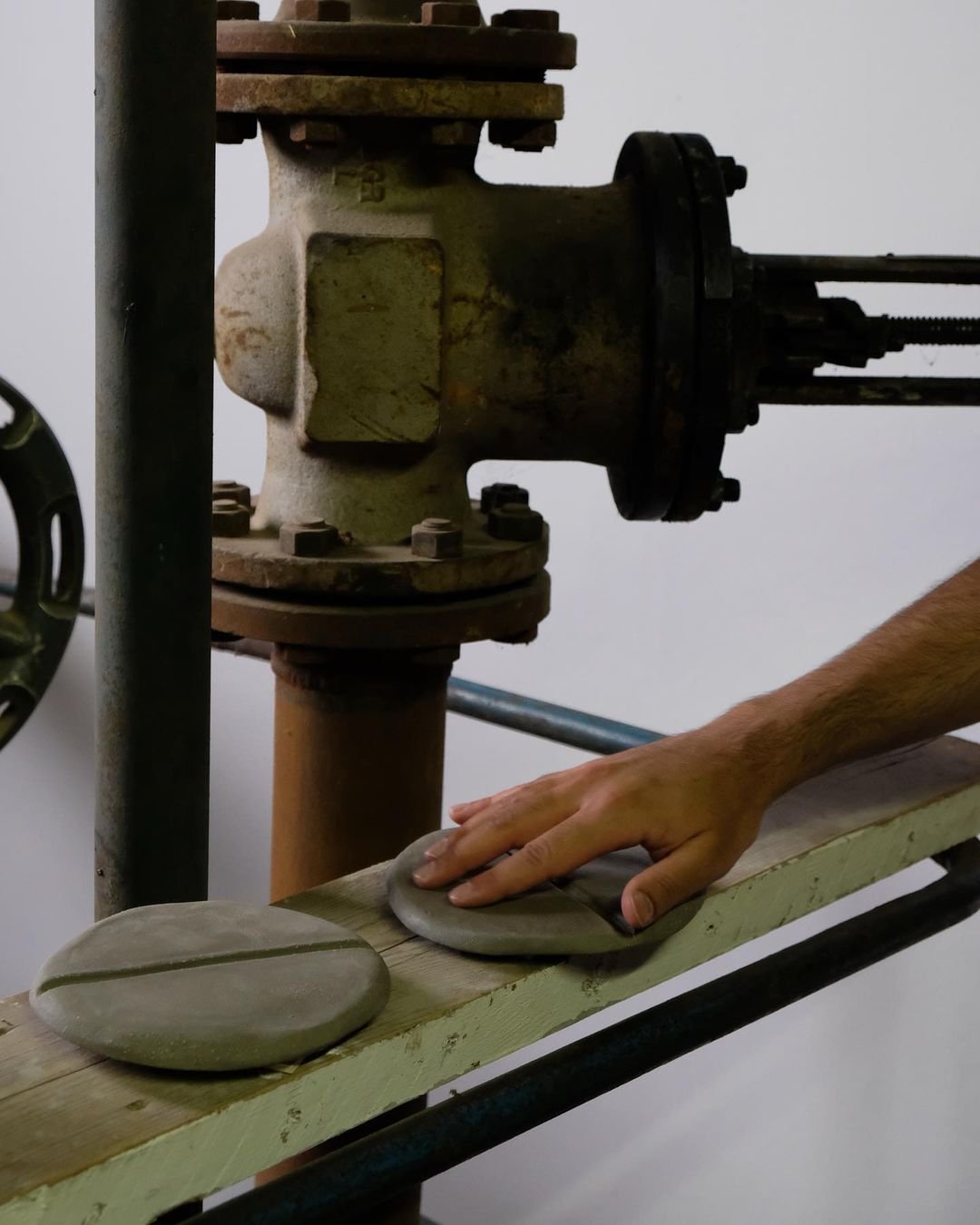Linda Zagidulina
In Linda Zagidulina’s latest installation, we are presented with a new take on traditional corporate briefcases that instead of holding business files and impersonal objects, they carry people’s most intimate feelings and memories. In her briefcases’ soft padded interiors, we can find the most unexpected objects, such as a stuffed microphone and tape recorder, a 3D-printed pair of shoes, a plastic moulded fax machine and an acrylic record. They are personal objects, handmade by the artist using upcycled materials and are elements of what she calls ‘Radio Briefcases’.
Displayed open to the public, they seem to be trying to communicate through coded messages, impossible to decipher from an outsider perspective but becoming more and more familiar as we get closer.
In our conversation Linda explains how collective histories can live through in objects and how the female figures in her family and in world history are a big inspiration to her practice. We also discussed the relationship between work and mental health in today’s world and how science fiction can help us explore difficult subjects in simpler ways.
In the accompanying text of your latest solo exhibition, ‘Agency of Internal Affairs,’ you describe a mysterious undercover agency that does not work for money but emotion, or as you refer to them, ‘impulses’. Was there a particular reference that inspired you to create this agency?
I think it’s a reference to fictional and sometimes sci-fi scenes that can describe clear or simple intentions, I quite like that they don’t actually place characters and scenery, the two rather recreate an essence of something else in between the lines. At the same time, I made these characters to be serious about the overall work and about the inner emotional processes we all have and neglect sometimes. That’s why I wanted to create an “agency” with a world level of significance about everything that we individually go through inside, and thinking that there’s also someone there to help make it easier 24/7. These characters always on the move (as our thoughts running 24/7 on the inside) are just like actual impulses in physics. In mechanics, velocity and force are dependent on impulses as they affect the overall performance of the object. Well, I guess this example is more specific than a whole human being but understanding that metaphor as a principle for my work, I wanted to make these impulses more visible and imagine what drives us to do our best and worst results as if there was a cheer team or a whole corporate agency working on it.
Besides being a mental support company, the agency works 24/7, which exposes a contrast between work and mental health. Were you thinking about the current work culture when making this project?
Yes, definitely. I’m invested and concerned about how mental health and general wellbeing are neglected and only matter when it concerns work profit. Like how desire and dreams are pretty much a currency that also shapes our relationships with ourselves. I guess it’s obvious I’m a big fan of science fiction. It’s very interesting that so many authors don’t give humankind a chance to reinvent the system we live in, how we always give priority to work as it represents notions of identity, status and also life itself. So I guess with my system, I’m trying to imagine that there’s something else that helps us go through the day and we can focus on other things and think about how that hint of the corporate can actually be caring about us too. I do think it’s utopic, but following the route of sci-fi narration, I think it helps to build one’s own perspective on the issue.
Earlier you mentioned that simple intentions are sometimes better described in science fiction. Why do you think that is and how do you implement it in your work?
I guess they’re not simple per se but in a way, the worlds created in sci-fi works aren’t usually considering a million external reasons shaping society, because they are trying to make us see a particular point. It’s quite often a very direct concept for the world or an intention for the world to be, that the characters have to figure out. I do like other approaches too, like War & Peace, for instance. You get to dive into every single more and less relatable detail. But I think the idea of accepting something very different from our world is what attracts me to science fiction. For me, it sparks a genuine sense of acceptance in a way, trying to understand something more complex on the basis of simple things. I guess that’s how you could also describe my impulse characters.
As the very title suggests, your ‘Radio Briefcases’ seem to be trying to communicate between them, with some emitting sounds, showing automated messages or having an inscribed sentence, written both in English and Volga Tatar. Would you say that these different approaches to language and communication are a reference to your personal experience or were you looking at them from a science fiction perspective?
I quite like when language is not exclusive when words reach others. But I also came across this thought by a contemporary Tatar poet Aigel Gaysina, about how some words in some languages can lose their essential meaning when you attempt to express or share certain things, as those words are overused. So the messages in these works are my comment on trying to describe briefcases, with my words as a dubbed voiceover, or subtitles, and not trying to speak for something else.
Thinking about your Tatar origins, there are also elements in your work referencing the women in your family as the use of your mum’s remnant fabrics and the 3D print of your grandmother’s shoes in ‘Heels Briefcase’. How much does your family history and especially the women in it influence your work?
I like the idea of used objects and I’m currently experimenting with upcycling, as a way to recite or study history by these materials being used again. And in relation to my selfidentity and trying to navigate what it means for me to be female today, I’m excited that I have a chance to use the field of research from my family histories (that quite often match with experiences of other female histories globally). I like the fact that they are very opposed to stereotyped or general historical facts. For example, Volga Tatar women are seen as humble and holding back wives, mothers and householders, even today. Culturally, this is based on literature and other post-Soviet tendencies as reviving traditions from the pre-revolution and pretty much ignoring the changes of the Soviet era. From my experience, all women in my family, going two-three generations back, had higher education and had respected careers (mostly because they were pushed by their times). For example, I was also obsessed with the story of Habib Tenisheva, who came from a respected Tenishev family based in the Volga region. In the 1890’s she established the first Mosque in the Penza region and an educational centre for everyone, as the region was (and still is) highly populated with Tatars. It was the first Mosque in the region for a while and it’s quite a shame that her memory isn’t celebrated as it should. Traditionally, Mosques are very masculine places, and it’s still like that in this Mosque today. Sadly, Tenishev’s estate was destroyed in a fire in the 1990s but the centre has been reopened now. Although, it’s more focused on teaching religion and the Arabic language to kids rather than preserving local identity in the region, as it was initially intended, it’s a centre for people who can feel safe and not need to adjust their identity, as well as to improve their education on all levels so they can have more opportunities outside their community. And it was created by a woman (in the XIX century!)
There is a very tactile character to your briefcases, which is partly created from them being completely handmade by you but also by referencing some nostalgic objects such as tax machines and record players. Do you think tactile experiences could be further explored in the digital realm or is this something you are interested in experimenting with in your next works?
It was quite performative how Ilya and Emilia Kabakov described intentions in their exhibition for Tate Modern, Not Everyone Will Be Taken Into The Future. I’d bravely add ‘everything’ too. It’s spectacular to look back now and see how initially, technologies starting with industrialization existed to picture a greater world ahead and were something like a Superman that helps everyone in this epic context. Today though, we’re more attached and reliable on technologies, seeing them more as extensions of ourselves from some point (quite literally if you take social media). They don’t serve to only fulfil some grand ideas anymore and they get outdated so fast. It’s very sad in terms of how promises can’t be kept or last longer, as our common sense tells us to keep the promises no matter what when you grow an attachment to someone. Perhaps, with technologies shifting their status and purpose - how they’re presented today, for what purpose, we’re too quite lost and trying to keep up with the fast-changing world and explain it to ourselves. I think climate change activism is a good example for such. How hard it was to accept the changing reality in the world we live in and see ourselves in a different role.
interview PIETRA GALLI
What to read next

















